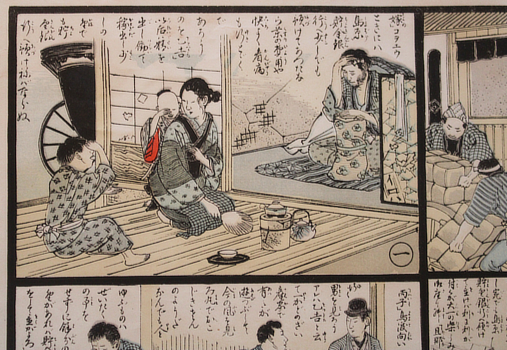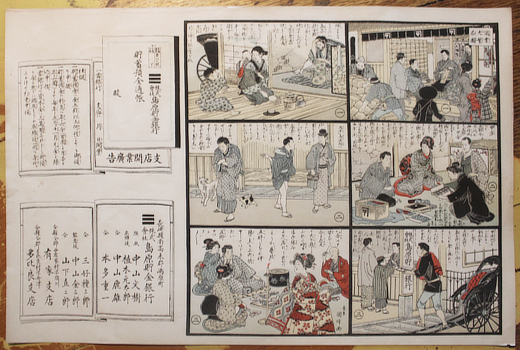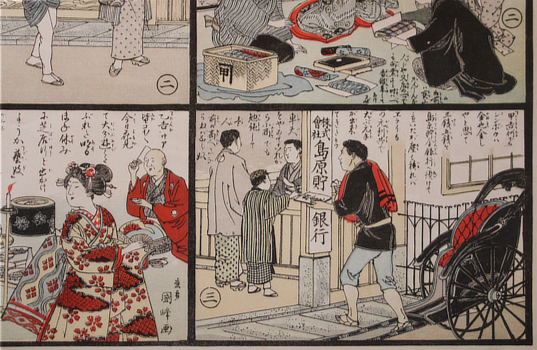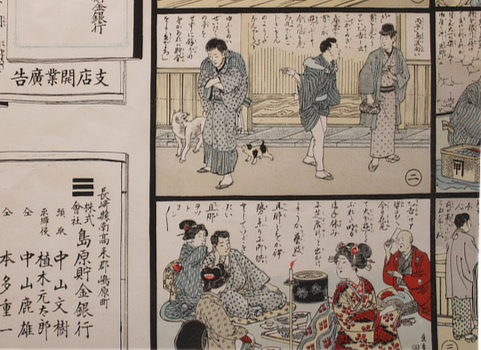





Exhibition. 博覧會圖式 [Hakurantaizushiki?]. n.p. Horaido [1872]. 26x36 lithograph? An excellent copy. Au$300
This clutter of bric-a-brac looks much like the oriental antique shop of my childhood dreams. This guide to the exhibition of antique artworks was the starting point for Tokyo National Museum's 150th Anniversary exhibition but their publicity gives us no details beyond the date 1872. I guess you had to be there.
Note that there are some western items included: a few paintings, those busts, what looks like a group of figurines ... The only other record I can find is the title in a gathering of prints called Meiji Restoration Surimono in a Kyoto museum.






Sarah S. Cornell & Toriyama Hiraku. 天然地理学 [Tennen Chirigaku] Tokyo &c, Shoyusha 2533 (ie 1873 or Meiji 6). Three volumes, 22x15cm publisher' wrappers with title labels (marked). Coloured illustrations, maps and diagrams. Smudges and minor signs of use; rather good, specially for a school book. Au$500
Cornell's Primary Geography was printed in English for Japanese schools in 1866 - one of the first western school books in the country. I'm not sure which of her books has been translated here and I doubt it matters much. I guess they did their job: to mislead children, bore them, and induce a dislike of geography. The Japanese versions are nicer to look at than the blobby grey American originals.




Dokufu. Ochiai Yoshiki (aka Utagawa Yoshiki). 悪漢茂吉と毒婦つまが縄ぬけ逃亡 [Akkan Mokichi to Dokufu Tsuma Ga Nawa Nuke Tobo]. [This title is taken from Tokyo University's catalogue and it has been used by others. I take it to be a paraphrase of the text]. Tokyo 1874 (Meiji 7). 36x24cm colour woodcut by Yoshiku. A nice copy. Au$450
Issue 220 of the special colour supplement to the Tokyo Nichi Nichi Shimbun (Tokyo daily news) which captures the villain Mosuke or Mokichi and his Poisonous Wife escaping their captor after they were captured in August 1872; the original article appeared in October 1872 but it took a while to develop the picture. I'm uncertain about our villain's name: he is Mokichi in the text but Mosuke in the banner beside him. Cataloguers usually follow the text.
A peasant's wife who cripples herself in the field alongside her husband is a model wife. A clerk's wife who festers at home and cripples her children is a model wife. But let the wife of a vicious thug, who is after all a worker, share in her husband's work ... poisonous woman. Thank heaven the world's not like that any more.
Dokufu, poisonous women, are for all time but the first few decades of the Meiji, with the advent of western style newspapers, made for rich pickings.







Nishimura Kanebumi. 開化の本 : 初編 [Kaika no Moto : Shohen]. Kyoto, Sugimoto Jinsuke 1874 (Meiji 1874). 23x16cm publisher's wrapper with printed title label; double page colour frontispiece and three double page b/w illustrations. Au$600
Nishimura was an imperialist and an anti-foreigner: they were all to be expelled. Kaika no Moto translates as the Book of Civilisation; it's part one but there was never a part two. A quick glance at the first picture might tell you where he stands but there's much going on in those illustrations I don't understand. A literal translation is of little help when you don't understand what it means. Why is that castle of books being blown up? I have no idea.
Nishimura was a much respected appraiser of treasures but it seems he was given to the odd bit of forgery of documents and single sheet editions. A couple of his scholarly books come with a warning about false publications but it has been said that, unlike thief and forger Thomas Wise, he wasn't in it for the money.





Albumen photograph of a young Japanese woman dressed as a man. n.p. c1880? Albumen print mounted on card, 6x10cm, with red border, printed on the back. Edges of the print a touch nibbled. Au$650
Inscribed on the back is, I'm told, 吉原江戸町 大文字楼 半太夫 - Yoshiwara Edomachi Daimonjiro Handayu. The Daimonji was one of the grandest of pleasure palaces in the Yoshiwara.
I'm not convinced by this inscription. Another photograph from the same source had a similar inscription on the back in a different, possibly earlier, hand: 大文字 ??太夫 - Diaimonji _ _Tayu. Tayu can mean a high ranking courtesan and certainly that photo is of a completely frocked out woman in a frocked out setting. But our photo is in a different setting on a different mount.
This could be a portrait of a woman dressed to suit the taste of some clients. But that coat, waistcoat and maybe shirt collar seem too large for a properly tailored suit and it is a gentleman's outfit, from hat to watch chain. Or the inscription could be a decision made by an owner of both photos that this was a courtesan of that brothel. It seems to be a common decision that any woman dressed as a man was a prostitute.
They both look like they were taken in photographers' studios. The undoubted courtesan has some props: an overwhelming robe is on the wall behind her, she has a charcoal brazier and kettle, a dish of snacks and a long pipe. They are both on western looking carpets, not the same one.
*In Chinese 半太夫 can be an unmarried woman or it could be a woman who is not afraid of the enemy.




Yokohama. 横浜実測図 [Yokohama Jissokuzu] Map of Yokohama. Tokyo, Naimusho Chirikyoku 1881 (Meiji 14). 117x181cm engraving on four joined sheets; folded. An excellent copy. Au$650
An impressive survey map, a bit larger than a tatami, so not to be unfolded in your average worker's boarding house room. I don't know why that average worker wanted this map, nor how they got it, but they would have to explore Yokohama fold by fold.
The bureau of geography was established in 1874 and mapping of the Kanagawa prefecture began. It all stopped as departments were abolished, merged and renamed. Mapping was completed and this map published in February 1881. I don't know about other maps. This one is uncommon enough, Worldcat finds only an 1883 printing with none outside Japan.






Tattooed woman outlaw
Ito Kyoto. 鳴渡雷於新 [Naruto Kaminari Oshin ?]. Tokyo, Kinsendo 1886 (Meiji 19). 18x12cm publisher's colour illustrated boards with cloth spine; four illustrations, three double page. A fabulous copy in a chic case by binder, writer and fastidious collector Atsuo Ikuta. At first I thought this had somehow been recased with new endpapers but the whole book is on the same almost translucent paper and it all matches exactly a shabby copy I found illustrated. Au$500
This might appear to be the first edition but it turns out that an edition appeared in 1883 from a different publisher with different illustrations. This is the story of the tattooed woman desperado Kaminari (or Rai?) Oshin - Naruto Kaminari might translate as roaring or raging thunder.
This immediately reminds us of Benten Kozo Kikunosuke - the tattooed woman outlaw who was outed as a man when a glimpse of her tattoos was seen; Benten was the star of kabuki plays and novels. That story hinged on the premise that no woman would be tattooed like that.
Of course this is the true story of a real person and there's no question that our heroine is a heroine. Nor that she's tattooed. On her back is Keisai Eisen's Hojo Tokimasa; on her buttocks is a dragon; on her thighs is a picture of Iwami Jujiro slaying a giant snake; on her stomach is one of the heroes from "Suikoden", Kumonryu Shijin; on her right arm is Kintaro; and on her left arm is a portrait of four people. A photo exists of what is supposed to be her skin which, in accord with her will, was tanned. It was exhibited in the Taisho period but has since been lost.
She was supposedly still alive and maybe in prison when this book appeared. She had been sentenced to life imprisonment in 1874, escaped in 1882 (see the explosive illustration), was arrested again and pardoned in 1889. She died, probably of TB, the next year, age about 40.
Worldcat finds no copies of this book. Cinii finds four entries for the 1883 edition in Japanese university libraries but not this.




Tobacco hikifuda. Iwaya & Co. Hikifuda by Iwaya & Co for their Shotengu cigarettes and other brands from American manufacturers Wm. S. Kimball and S.F. Hess Tokyo? Iwaya c1890? 27x38cm illustrated lithograph. Folded and frayed around the edges; pretty decent. Au$100
Iwaya Matsuhei was a promoter's promoter. After a few false starts - the odd incendiary rebellion, lawsuit and bankruptcy - he got into tobacco in the 1880s. Importing and learning from American companies like Kimball and manufacturing his own Tengu cigarettes from about 1884. He was soon a flamboyant plutocrat about town, bannering how much tax he paid and how many charity workers he supported (a lot). Soon came the great Tobacco Advertising War between Iwaya and his rival Murai Kichibei.
This restrained hikifuda, which features more of Iwaya's imports than his own brands must come early in the history. Shotengu - small Tengu - was only one of a panoply of Tengu cigarettes - large Tengu, medium, gold Tengu, silver Tengu ... through to happy nation Tengu.






Kobayashi Ikuhide. 上野公園風船の図 [Uenokoen Fūsen no Zu]. Tokyo, Sakai Kinzaburo, January1891 (Meiji 24). Colour woodcut 36x24cm. At sometime mounted on tissue with what was probably a hinge on the right edge. A nice bright copy. Au$1150
The brightest, busiest and most impossible of the Ueno Park balloon prints. Aeronaut Percival Spencer, of the Spencer aeronautic dynasty, came to Japan in 1890 with his balloons and parachutes, performing his balloon ascent and parachute descent stunts in Yokohama and in Ueno Park in Tokyo in November 1890. He is said to have injured himself slightly having to avoid the royal tent during a command performance. Tokyo went balloon mad - again, they had a craze years earlier - and Spencer's performance was made into a Kabuki dance play - Fusen Nori Uwasa Takadono (Riding the Famous Hot-Air Balloon, see Brandon; Kabuki Plays on Stage) by premier dramatist Kawatake Mokuami - which ran for a month in early 1891. The Kabuki star Kikugoro V (who played the demon princess in the 1899 film Momijigari) played Spencer with waxed moustache, hat and learnt a short speech in English for the finale.
I think all the other balloon prints of Spencer in action are actually Kikugoro in action and this fantasia is also a theatre print: those are actors' names on the balloons. We might think of this as an advertisement for the play that had begun, or was about to begin, its run. But front and centre is the name of Ichikawa Danjuro, who shared the top rung of the star ladder - but not this play - with Kikugoro and I can't see Kikugoro's name anywhere.




堺祥雲寺五葉松之図 [Sakai Syounji Goyomatsu-no-Zu]. Kyoto, Maeda Kazuyoshi 1892 (Meiji 25). 25x33cm lithograph; folded. sold
Truth in advertising? We all know there never has been any, but still. A photograph from about 1895 shows the fabulous old pine tree of the Shounji temple in Sakai near Osaka about one storey high at its peak, but the camera does lie. Or maybe I'm wrong and our artist (Kouseki?) is faithful to the awe instilled in the visitor. The tree was destroyed by an air raid during the war and I believe a still infant tree was planted to replace our tree in a few hundred years.
Ancient tree in an ancient temple maybe, but this view is aimed at the modern tourist, what with that western transliteration, and the urbanites outnumber the pilgrims by 50%.






Japanese Earthquake Architecture. [Report of the Earthquake Disaster Prevention Investigation Committee: Survey of buildings damaged in the earthquake in Yamagata Prefecture]. Tokyo 1895. 25x18cm publisher's printed wrapper; folding map, plans, heaps of plates, some folding. Used, missing the back wrapper, some staining - but nothing fatal - and corners gone from the last two leaves. A worthwhile copy. The 7th report from the committee. Au$450
A splendid report bulging with lithographs from careful drawings - much more useful than photos - made after the Shonai earthquake of 1894.



Japanese Earthquake Architecture. [Report of the Earthquake Disaster Prevention Investigation Committee: earthquake resistant structures]. Tokyo 1895. 25x18cm publisher's printed wrapper; 28 folding measured drawings (some quite large), 26 smaller drawings on six plates. The 6th report of the committee. Au$150
Plans and specifications for improved structures for a townhouse, a farmhouse, and a school, after the 1894 Shonai earthquake.




Japanese Earthquake Architecture. Report of the Earthquake Disaster Prevention Investigation Committee: Earthquake-resistant house investigations. Tokyo 1897. 25x18cm publisher's printed wrapper (a bit grubby, closed tear in the back cover); 24 quite large measured drawings and plans, photo plates, several folding. Used but nothing serious. The 13th report of the committee. Au$150





Banking. 株式会社島原貯金銀行 : 支店開業広告 [Kabushikigaisha Shimabara Chokinginko : Shiten Kaigyo Kokoku]. n.p. [c1898] Colour lithograph 26x39cm. A nice copy. Au$300
This gentle, charming advertisement - hikifuda - announcing branch openings of the Shimabara Savings Bank is illustrated by two reassuring stories of rags to riches - or solid comfort at least. The Shimabara Bank was founded in 1891 and the Shimabara Savings Bank in 1897 but didn't live long thanks to some investment decisions by the Nakayama family - three Nakayamas including president Fumiko are listed among the directors.
Shimabara is in the Nagasaki prefecture and the two branches advertised are Arie - a town that was engulfed by Minamitakaki City - and Taira - which I can only trace as a railway station in a desolate looking area of Unzen, Nagasaki. Dates for month and day have been left blank.






Amano Kaoru (preface). 探偵実話 : 岩井貞藏 [Tanteijitsuwa : Iwai Teizo]. Tokyo? Nakamura Sojiro 1898 (Meiji 31). 21x14 publisher's colour illustrated wrapper; three double page illustrations. With expert repairs to the spine and a new back wrapper. An excellent, fresh copy in a case by binder, writer and fastidious collector Atsuo Ikuta. Au$200
First edition. I bought this under the heading of, (roughly translated) Real life heinous murderer. We can discard the real life immediately. The preface is by Amano Kaoru, almost as obscure as anonymous, the author. I can't find a record of this anywhere but a publisher's advertisement in another book.






Lightning Robber. 稲妻強盗 : 坂本慶次郎 [Inazuma Goto : Sakamoto Keijiro]. Tokyo, Sanshindo 1899 (Meiji 32*). 21x14cm, publisher's colour illustrated wrapper; three double page illustrations. The wrapper and last leaf (this was not issued with a back wrapper, an advertisement leaf was joined to a stub of the cover and spine) have been repaired but I'm not sure how much. It is so near invisible. An excellent, fresh copy in a chic case by binder, writer and fastidious collector Atsuo Ikuta. Au$250
Third edition, three months after the first. The Lightning Robber - Inazuma Goto, the title of this book - was Sakamoto Keijiro, arrested in February1899 after escaping jail in 1895, a lot of robberies and three murders. This was the stuff of sensation mongering of course, plays were performed in 1897 and 1899. In 1899 four or more books called Lightning Robber appeared; that is, I found four titles but I don't know how many of them are different books.
This seems to have 24 more pages than what is likely the first edition, published by Kinshindo, and either uses the same sheets or was printed from the same plates.
*But. Those extra pages finish with his death in February 1900, months after the date on the colophon printed on the other side of the same page. Can publishers ever be trusted?
The Lightning Robber was conflated with the previous decade's Pistol Robber and one of our four or so books shows him in bowler and overcoat firing at a policeman. Japan's first feature film, 'Pisutoru Goto Shimizu Sadakichi' (pistol robber Shimizu Sadakichi) but also called 'Inazuma Goto', appeared the same year.
Worldcat does not find this version and none of their four titles are found outside Japan.